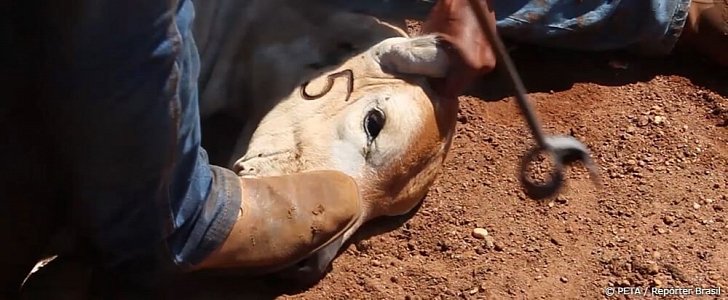Let’s get one thing straight: cows are awesome. Not only do they produce the milk and dairy products we drink and eat every day, but they’re also good as draft animals. Their manure, on the other hand, can be used as fertilizer. Cows are even worshiped in India for how awesome they are. In Brazil, however, cows put their lives down in the most gruesome of ways, as revealed by PETA.
The video at the end of this story is an animal cruelty expose aimed at JBS, the largest leather processor in the world. Every year, JBS processes the hides of approximately 10 million cows. To put that output into a perspective, the automotive industry needs something like 45 million cow hides per year.
PETA and nonprofit organization Reporter Brasil produced the video expose and, before deciding to press play, you should be warned that the clip abounds with violence toward animals. As the investigation shows, the life of a cow in a Brazilian leather processing company is not only short, but painful.
When they’re young, calves are dragged away from their mothers, get wrestled to the ground, after which a thumping great hot iron is used to brand their faces with a number. That’s JBS’ idea of cattle ownership.
People for the Ethical Treatment of Animals notes that as per the minimum animal-welfare recommendations of the Brazilian Ministry of Agriculture, that also happens to be a big no-no due to the lack of any pain relief whatsoever.
As the calves grow into cows, the abuse continues with electric prods. When the cows turn three years old, they’re taken to JBS-owned slaughterhouses, where they’re throats are slit. Hung upside down, the dead cattle is bled to death, after which skinning ensues. The hide which results from this procedure is then treated and turned into the leather you might find on your vehicle’s steering wheel, gear stick, seats, dash, and door panels.
Don’t get me wrong; I love the beef in my burger, but this is no way to lay down the life of a cow. Depending on the region, there are more humane ways of using a cow for our self-indulgence. The captive bolt pistol or electronarcosis are two ways to kill a cow without making it feel pain. The second of the two methods renders the cow unconscious before slaughter.
PETA and Reporter Brasil accuse many automakers of supporting Brazilian leather supplier JBS by buying hides without caring about how the animal is turned into leather for the automotive industry. The names range from volume manufacturers such as Ford, Ram, Subaru, and Hyundai to premium and luxury manufacturers like Porsche, Cadillac, Jaguar, and Mercedes.
I won’t judge anyone whose car features a leather interior. Bear in mind, though, that the leather in your vehicle might have come from a cow that suffered what can only be described as a disturbingly brutal death.
On that note, the interior of a standard-specification Bentley Mulsanne needs as many as the hides from 16 cows. Thankfully, though, the British brand isn’t on PETA's and Reporter Brasil’s naughty list for cattle cruelty.
PETA and nonprofit organization Reporter Brasil produced the video expose and, before deciding to press play, you should be warned that the clip abounds with violence toward animals. As the investigation shows, the life of a cow in a Brazilian leather processing company is not only short, but painful.
When they’re young, calves are dragged away from their mothers, get wrestled to the ground, after which a thumping great hot iron is used to brand their faces with a number. That’s JBS’ idea of cattle ownership.
People for the Ethical Treatment of Animals notes that as per the minimum animal-welfare recommendations of the Brazilian Ministry of Agriculture, that also happens to be a big no-no due to the lack of any pain relief whatsoever.
As the calves grow into cows, the abuse continues with electric prods. When the cows turn three years old, they’re taken to JBS-owned slaughterhouses, where they’re throats are slit. Hung upside down, the dead cattle is bled to death, after which skinning ensues. The hide which results from this procedure is then treated and turned into the leather you might find on your vehicle’s steering wheel, gear stick, seats, dash, and door panels.
Don’t get me wrong; I love the beef in my burger, but this is no way to lay down the life of a cow. Depending on the region, there are more humane ways of using a cow for our self-indulgence. The captive bolt pistol or electronarcosis are two ways to kill a cow without making it feel pain. The second of the two methods renders the cow unconscious before slaughter.
PETA and Reporter Brasil accuse many automakers of supporting Brazilian leather supplier JBS by buying hides without caring about how the animal is turned into leather for the automotive industry. The names range from volume manufacturers such as Ford, Ram, Subaru, and Hyundai to premium and luxury manufacturers like Porsche, Cadillac, Jaguar, and Mercedes.
I won’t judge anyone whose car features a leather interior. Bear in mind, though, that the leather in your vehicle might have come from a cow that suffered what can only be described as a disturbingly brutal death.
On that note, the interior of a standard-specification Bentley Mulsanne needs as many as the hides from 16 cows. Thankfully, though, the British brand isn’t on PETA's and Reporter Brasil’s naughty list for cattle cruelty.






















